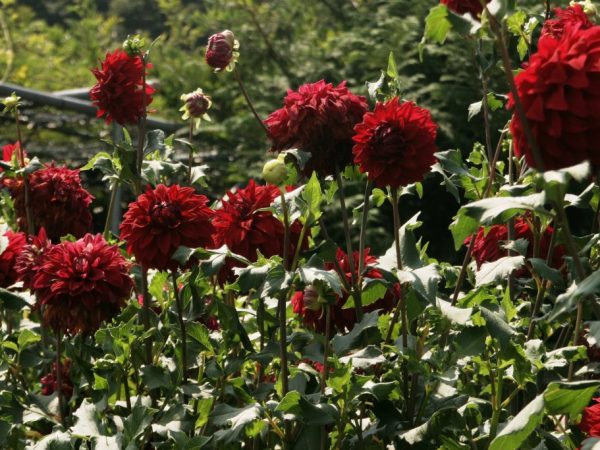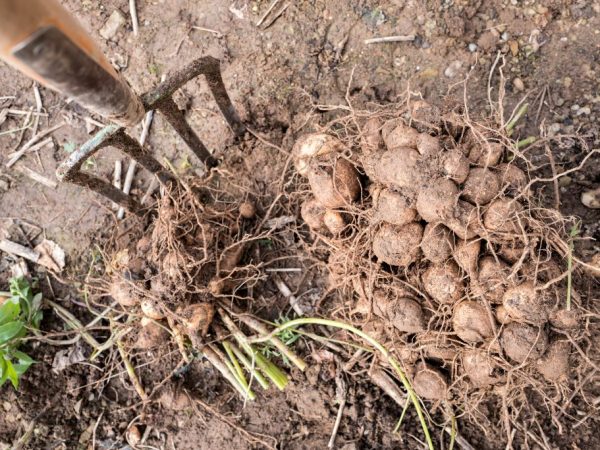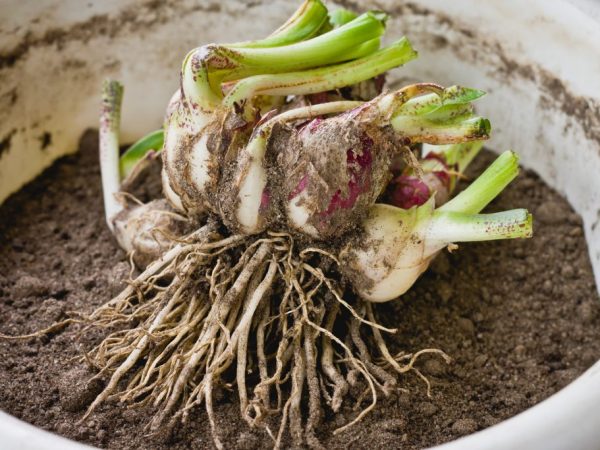When and how to dig dahlias in the fall
Dahlias are perennial herbaceous plants, but they do not winter well, so they need to be dug up in the fall. Bulbs can be planted in open ground only in spring, when it gets warm.

When and how to dig dahlias in the fall
Cleaning time
When determining the optimal timing, one should take into account, first of all, regional peculiarities.
- Early harvesting of bulbs badly affects their safety in winter, because they have time to collect the required amount of nutrients.
- If you shift the dates of laying, the risk of freezing of the root tuber increases due to the onset of autumn frosts.
Central lane and Moscow suburbs
In warm climatic areas, flowering ends by mid-autumn, around October.
This is the right time to dig out the onion, which is already ripe for wintering, filled with nutrients.
The term is shifted towards the beginning of the winter season, when short-term frosts are observed, but severe frosts are not expected.
Dry and withered stems and foliage will tell you about the readiness of the tubers for laying.
North
In northern areas, incl. in the Urals, Siberia, the Leningrad region, the risk of sudden autumn frosts is increased, therefore they have been trying to dig dahlias since the end of September.
In case of an unexpected strong drop in temperatures, it is recommended to get the tubers out of the soil in 3 days.
Dahlia varieties with dark buds are characterized by low frost resistance. They are sent to store before others.
South
Florists of southern climatic zones can postpone digging out the bulbs for 1-2 weeks longer compared to the central strip, approximately at the end of October - the first days of November, provided that the weather remains warm.
Bookmarking rules for the winter
Before digging dahlias in the fall, you need to remove the aboveground part, leaving stems up to 0.2 m long.
Weakened and diseased plants are not preserved - they are burned to avoid the spread of infectious diseases and the preservation of pest larvae in the ground.
Digging into the roots, they retreat a sufficient distance so as not to damage the corms.

The dug out flower must be dried
Instructions:
- Initially, the bush is dug in around the perimeter and, using a shovel, is removed along with the roots and earth.
- The earth is shaken off, the flower is left to dry out in natural conditions.
- The stems are cut to 7-10 cm.
- Thin roots are removed under the base.
- The fresh green shoots present on the root tubers are broken out at an angle so that in winter they do not grow ahead of schedule.
When removing the plant from the ground, do not pull the stem, because this will lead to a violation of the integrity of the roots and negatively affect the preservation.
Flower bulbs are washed under running water to remove soil residues and soaked in a disinfectant solution designed to increase the shelf life of the planting material.
For disinfection, ordinary potassium permanganate, diluted to a light pink color, is suitable.After processing, the tubers are laid out to dry in natural conditions.
Storage melt
Training
Before laying for home storage, many growers divide the bulbous nest into parts, leaving along the neck with buds and cutting off all remaining roots and shortening the stems to the maximum possible length.
Separation allows you to store planting material without the appearance and spread of rot.
In the process, the tubers are examined and sorted, cutting out rotten fragments to a healthy layer, processing them after pruning with brilliant green. Leave only those that, as a result of the sanitary procedure, have retained at least 1/3 with the kidneys. Smaller delenki are thrown away.
The presence of holes indicates pest damage, but is not an obstacle for storage.
Completely discolored necks that have begun to deteriorate cannot be bookmarked.
Onion cuttings are washed with water, the sections are treated with a fungicide and left for 6-10 days to tighten the wounds on the roots and form a thin crust on the surface, preventing excessive evaporation of moisture.
It is not worth preserving the uterine root of the plant, because he will give only weak shoots in the next season.
The necessary conditions
Before sending for wintering, root tubers should be marked so as not to confuse varieties. This will make it easier to plant flowers for the next season.
Correct microclimate:
- temperature within 3-7 ° С;
- humidity from 80% and above;
- well-organized ventilation;
- isolation of root tubers from each other, avoidance of contact;
- laying with the root collar downward.
A small amount of planting material is stored in a refrigerator, avoiding the proximity with vegetables, because high humidity becomes the cause of the appearance of fungal diseases.

Tubers can be stored in the refrigerator
A large volume is placed in separate containers - buckets and plastic or wooden boxes, cardboard boxes and placed in the basement, on the balcony or in the cellar.
In any method of laying, the tubers are shifted with an auxiliary substrate or a suitable material.
- Wood sawdust. A simple and affordable method to save planting material. A coarse fraction or shavings are suitable, because fine sawdust will dry out the bulbs, drawing out all the moisture. Layout is possible in 2 rows with sprinkling with a layer of sawdust.
- Peat. A horseman approaches, with which the delenki laid out on wooden boxes are poured, leaving the necks half open. In winter, the peat layer is moistened to prevent the dahlias from drying out. Peat can be mixed with garden soil in a 3: 1 ratio.
- Earth. Bulbous cuttings are laid out in boxes lined with newspaper or paper and sprinkled with earth.
- Sand. River sand for backfilling planting material in storage tanks must be dry. The roots are immersed in 1-2 layers and covered with burlap on top. In winter, the sand is not moistened.
- Packages. Tubers are stored in polyethylene together with sawdust, which absorbs moisture, otherwise the process of rotting of root tubers will begin from the formation of condensation. The bag is tied, but holes are made over the entire surface for air access. Once every 2 weeks, the material is inspected for the appearance of mold and rot. The damaged copies are discarded.
- Film. Each section is treated with a fungicidal preparation or sulfur powder before laying, wrapped in a film, folded into a cardboard box.
- Bags. Dahlias are stored in canvas bags dry, without filler, hanging them at a height in the basement, apartment, cellar, avoiding contact with the floor, away from damp places.
- Paraffin. The most effective method, providing the highest percentage of safety. Suitable only for early varieties of dahlias, because after waxing, it is possible to wake up the bulbs much later. Recommended for storing rare varieties. The paraffin is heated to a liquid state in a steam bath and allowed to cool to an acceptable temperature.Each onion cut is lowered and held until a waxy crust forms. After processing, the root tubers are folded into a bag with sawdust and stored in a cool place.
- Clay. Like paraffin, it covers the root tuber with a protective layer and increases the shelf life. The clay is diluted to a thick state and the roots are dipped into it, allowed to dry and sent to a suitable container.
- Vermiculite. Granular material is suitable for pouring dahlias when they are stored in boxes or plastic bags. It is not used in rooms with low humidity, because it absorbs a significant amount of moisture from the surrounding air. When laying in boxes, layers of vermiculite substrate and root tubers alternate.
Care rules
Planting material laid down for the winter must be regularly inspected, in a timely manner removing rotten and moldy specimens. When the filler dries out, the bookmarks are moistened.
It will not be superfluous to protect the planting material from the attack of pests. For the treatment of storage tanks and root tubers, insecticides with a systemic spectrum of action are suitable. The container is sprayed, and the onion cuttings are immersed in an aqueous solution for 15 minutes.
Summing up
You can save dahlia tubers dug up in autumn in different ways in an apartment, basement, cellar and on the balcony. The main condition is to pre-prepare them and maintain the correct temperature and humidity.

